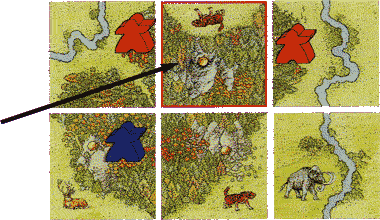

The special tiles have lovely artwork as well! I really appreciate when there’s still some detail involved with simpler games like this because it just helps bring them to life even more than they already do! There is also a scoring track that goes around the outside edge of the board so players can keep score throughout every game instead of having to remember how many points everyone has or writing everything down on paper somewhere. In the box, you will receive a large cloth map that represents where all of your pieces are going to be placed, a rules sheet, and hundreds of colorful meeples in four different colors. If you’re looking for a fun strategy game that anyone can enjoy then be sure to check out Carcassonne today! It’s great because not only is it easy to learn but it’s a ton of fun too!


The game ends when either all of the tiles have been played, there is no possible way for any players to place a tile, or one player has placed their final follower token which automatically makes them winner unless another player can surpass it by placing more followers before this happens in which case the person with the most would win if neither was able to do so than you will play additional turns until someone does (if necessary). The same thing goes for scoring cloisters but instead of being multiplied by ten they are only multiplied by five so keep this in mind while trying to form these special pieces! If you were able to complete a city or cloister during step three, then it is now time to score them! For example, if your piece was placed in such a way that made two separate cities into one larger city, you would gain points based on each of those individual scores added together before multiplying by ten to get their total combined value. Step Four: Score for Completed Cities/cloisters (if Present) Then take turns drawing a tile again but only draw one instead of two unless none remain in which case pick out another set of tiles and continue playing until all the pieces have been used up. Continue doing this until all 72 tiles have been used up or there is no longer an open space anywhere around existing path/city/cloister pieces. If any of your pieces have completed cities or cloisters (if present), then you must score those at this time as well.Ĭhoose two more tiles from the pile and place them where there are open spaces on either side of already played path pieces if available. Once each player has placed their followers onto the board, you are now ready for scoring. Each player only has seven followers that they can play, so it’s important to use them wisely! You may also choose not to play any follower token if you do not wish to at this time. Now comes time for your opponents and yourself to take turns playing follower tokens onto any open spaces surrounded by existing path pieces (if present). If there already exists paths or cities where you are placing this new piece, they will become part of your special pieces once finished being played.

The number of ways that these can be placed is endless, so it’s important to think strategically while drawing! Once you have your tile, place it somewhere on the board face up. The first step in Carcassonne is to draw one of the 72 tiles. The game is played by the players who draw and place a tile with an incomplete landscape composed of roads, cities, cloisters, or fields on them.
#BASIC CARCASSONNE RULES HOW TO#
Average Playtime: 45 minutes Sprawdź cenę How to Play Carcassonne.No matter how many times you play, there are always unexpected turns that will keep everyone on their toes! This makes Carcassonne great for all ages. As long as you have ~45 minutes to spare, this game will keep you entertained over and over again!Ĭarcassonne is known as a fun strategy game because it’s easy to learn and difficult to master. The rules are simple, but there is room for strategy! You can try your hand at this medieval world in just about half an hour, making it great for those with busy schedules. It’s played by drawing and placing randomly generated tiles as you build the city of Carcassone. This is a board game for two to five players. What Strategies Do People Use to Win at Carcassonne?.Step Four: Score for Completed Cities/cloisters (if Present).


 0 kommentar(er)
0 kommentar(er)
